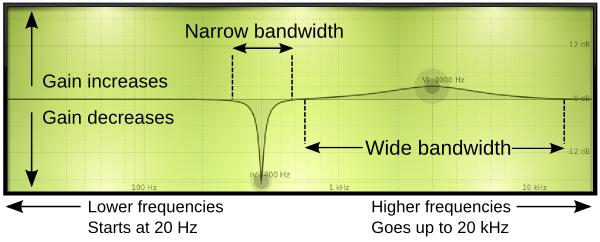EQ
Primary tabs
EQ, or equalizers, can manipulate the frequency response of audio material in various ways. There are 3 parameters that EQ's typically have, gain, frequency and Q. Gain relates to increasing or decreasing a specific frequency. Frequency relates to which frequency is being manipulated and Q, or bandwidth, relates to how many frequencies around the selected frequency are also affected.

A good rule of thumb with EQ is to use a narrow Q, or bandwidth, for cutting frequencies and a wider Q for boosting frequencies. This is because narrower bandwidths are more noticable and harsher when being boosted, while not being as noticable when being cut. Also, when you are cutting a frequency, you are most likely going to be cutting out a problem frequency. In such cases, you want to do this while not affecting too much of the surrounding frequencies, therefore a narrow bandwidth is better suited.
Another good rule of thumb is that your boosts should not be excessively large, as this can easily lead to harshness. A few dB should be enough in most cases. Cuts however can be larger without as much negative side effects, particularly when using a narrow Q.
In general, cutting problematic frequencies is encouraged before boosting frequencies. If you are boosting frequencies, be selective and have a reason for doing so. Boosting similar frequencies across multiple tracks can very quickly make a mix sound muddy (lower frequencies) or harsh (higher frequencies).
